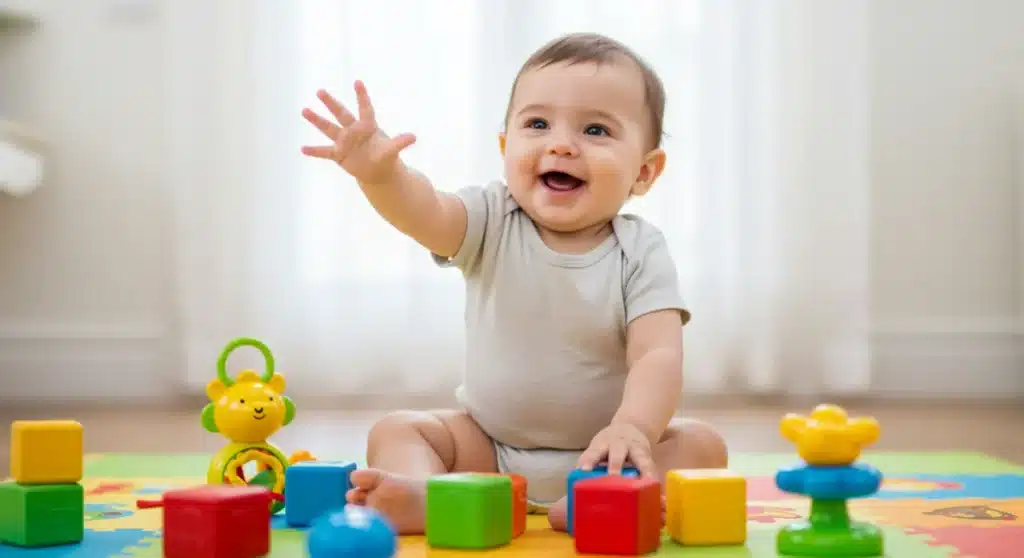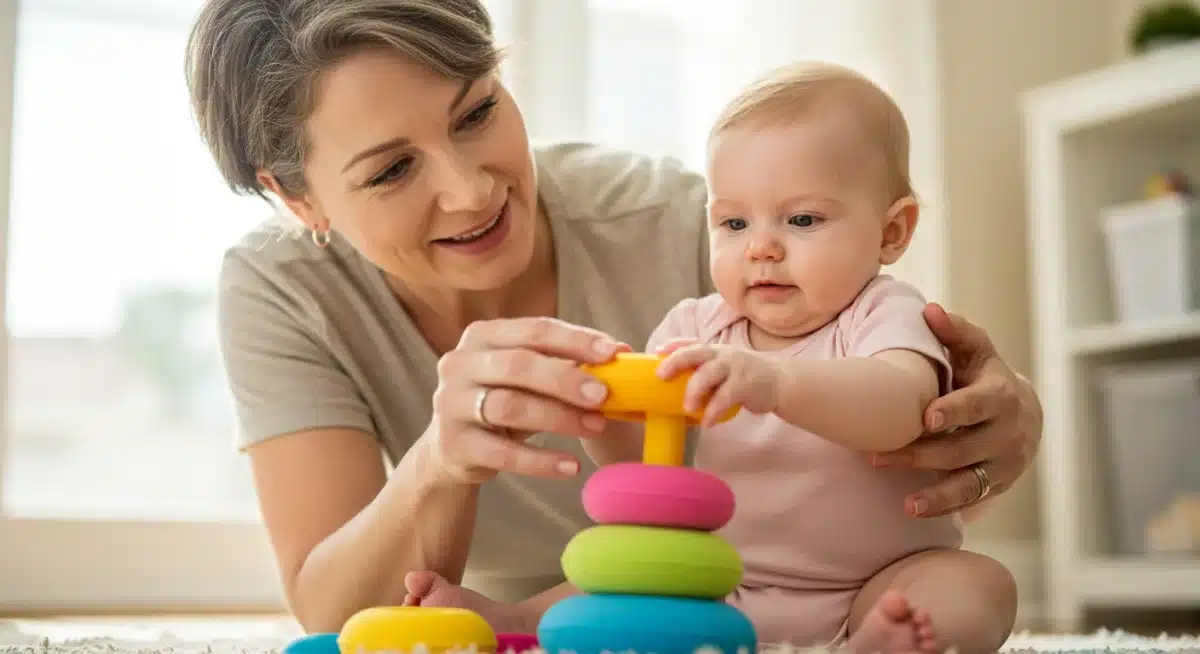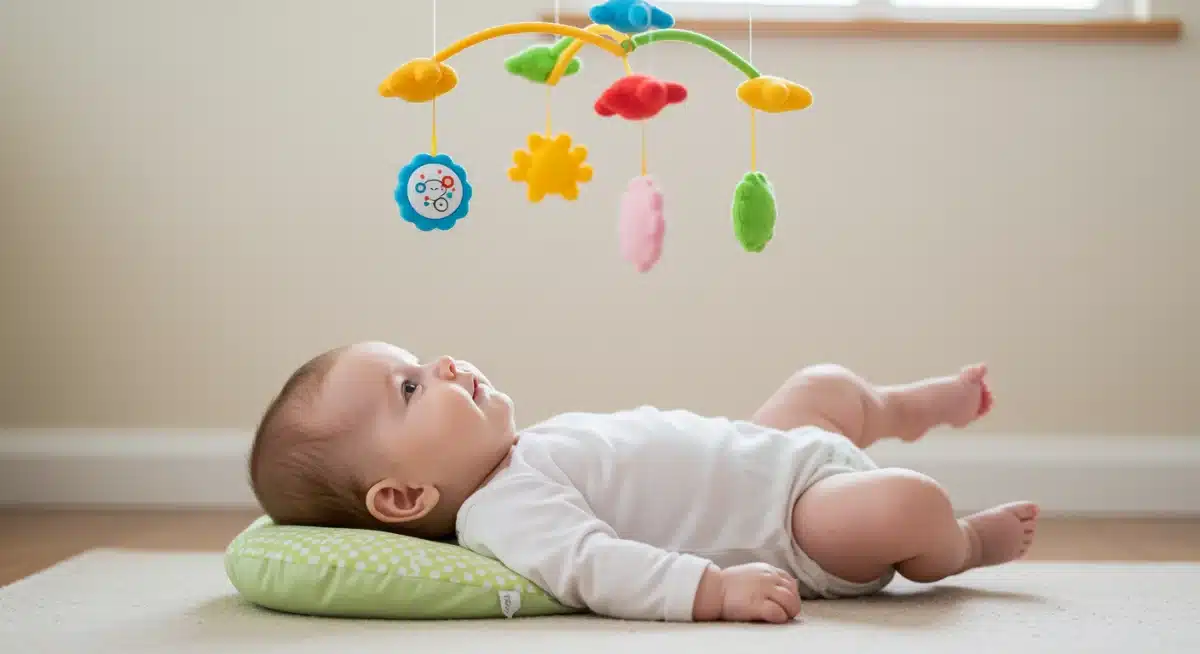Stimulating Baby’s Development: Fun Activities for the First Year

Advertisement
Engaging in interactive play and age-appropriate activities is crucial for fostering a baby’s comprehensive development across cognitive, motor, and social domains during their foundational first year.
The first year of a baby’s life is a period of remarkable growth and discovery, laying the foundation for future learning and development. Engaging in stimulating baby’s development: fun activities for the first year is not just about entertainment; it’s about nurturing their cognitive, physical, social, and emotional growth in profound ways. These early interactions shape how infants perceive the world and how they learn to navigate it.
Advertisement
Understanding Early Infant Development Stages
Before diving into specific activities, it’s essential to understand the general developmental stages your baby will experience during their first year. This knowledge helps parents choose appropriate activities that challenge without overwhelming, ensuring optimal engagement and learning.
Infants develop at their own pace, but there are common milestones that provide a useful guide. These milestones span various domains, including gross motor skills, fine motor skills, cognitive abilities, language acquisition, and social-emotional growth. Recognizing these stages allows parents to tailor their interactions and create an enriching environment.
Advertisement
The First Three Months: Reflexes and Early Connections
During these initial months, development is largely driven by reflexes. Babies are learning to control their head movements, track objects with their eyes, and respond to sounds. Activities should focus on gentle stimulation and fostering a sense of security.
- Tummy Time: Essential for strengthening neck and upper body muscles, preparing for rolling and crawling. Start with short sessions and gradually increase duration.
- Tracking Objects: Move colorful toys or your face slowly from side to side, encouraging your baby to follow with their eyes. This improves visual coordination.
- Sound Exploration: Talk, sing, and read to your baby. Introduce rattles and soft musical toys to engage their auditory senses and encourage sound localization.
- Gentle Touch: Cuddling, skin-to-skin contact, and gentle massages promote bonding and a sense of security.
The first quarter is all about establishing connections and building trust. Simple interactions like smiling, cooing, and holding your baby close are profoundly important for their social-emotional development. These early moments create a secure attachment, which is vital for future emotional well-being.
Engaging Activities for Cognitive Growth
Cognitive development in babies refers to how they think, explore, and figure things out. This includes the development of knowledge, skills, problem-solving, and dispositions, which helps them to think about and understand the world around them. Stimulating cognitive growth is about providing opportunities for exploration and discovery.
From birth, babies are constantly learning. Their brains are rapidly forming connections as they interact with their environment. Activities that encourage curiosity and problem-solving are paramount for fostering strong cognitive foundations.
Exploring Cause and Effect
Around 4-6 months, babies begin to understand cause and effect. This is a significant cognitive leap, as they learn that their actions can produce a reaction. Providing toys that demonstrate this principle is highly beneficial.
- Rattles and Shakers: Babies learn that shaking these objects produces sound.
- Activity Gyms with Hanging Toys: Kicking or swatting at toys makes them move or make noise.
- Push-and-Pull Toys: As they get older, simple push-and-pull toys teach them about movement and force.
Simple games like Peek-a-Boo also contribute significantly to cognitive development by teaching object permanence – the understanding that objects continue to exist even when they cannot be seen. This concept is fundamental to later problem-solving skills.
Reading aloud to your baby, even before they understand words, introduces them to language patterns and sounds, which is a precursor to literacy. Choose board books with bright colors and varying textures to engage multiple senses.
Fostering Fine and Gross Motor Skills
Motor skill development is crucial for a baby’s independence and exploration. Fine motor skills involve the coordination of small muscles, such as those in the hands and fingers, while gross motor skills involve larger movements, like crawling, sitting, and walking.
Providing opportunities for both types of motor development ensures a well-rounded physical foundation. Babies learn by doing, so giving them space and appropriate tools to practice these skills is key to their progress.

Developing Fine Motor Coordination
Fine motor skills are refined throughout the first year, progressing from grasping reflexes to more deliberate movements like picking up small objects. These skills are essential for self-feeding and eventually writing.
- Reaching and Grasping: Offer toys within reach, encouraging your baby to stretch and grab. Vary the textures and shapes of the toys.
- Transferring Objects: Once they can grasp, encourage them to pass a toy from one hand to the other.
- Stacking and Nesting Toys: Simple blocks or nesting cups help develop hand-eye coordination and spatial awareness as they approach their first birthday.
Finger foods, when introduced, are excellent for practicing the pincer grasp, where the baby uses their thumb and forefinger to pick up small pieces of food. This is a significant milestone in fine motor development.
Enhancing Gross Motor Development
Gross motor skills are the foundation for mobility. From rolling to crawling to eventually walking, these movements require strength, balance, and coordination. Creating a safe and encouraging environment is important for practice.
- Tummy Time Progression: As babies get stronger, they’ll push up on their arms, pivot, and eventually begin to crawl.
- Supported Sitting: Help your baby sit upright, first with support and then gradually letting them balance independently.
- Cruising: Once they can pull themselves up, encourage them to move along furniture, building leg strength and balance for walking.
Providing ample floor time allows babies to explore and practice these movements naturally. Avoid excessive use of baby containers like bouncers or swings, as they can limit opportunities for natural movement and muscle development.
Promoting Language and Communication Skills
Language development begins long before a baby utters their first word. It encompasses understanding sounds, gestures, and eventually, spoken language. Parents play a critical role in fostering these early communication skills through consistent interaction.
Babies are naturally attuned to human voices and expressions. The more you talk, sing, and read to them, the richer their linguistic environment becomes, paving the way for their own vocalizations and comprehension.
The Power of Conversation
Even though babies can’t respond with words, engaging them in conversation is immensely beneficial. Respond to their coos and babbles as if they are meaningful contributions to a dialogue.
- Narrate Daily Activities: Describe what you’re doing as you change a diaper, prepare food, or go for a walk. “Now we’re putting on your blue socks.”
- Respond to Sounds: When your baby coos or babbles, make eye contact and respond with words. This teaches them about turn-taking in conversation.
- Sing Songs and Rhymes: Repetitive songs and rhymes introduce rhythm and intonation, which are fundamental to language.
Reading picture books and pointing out objects while naming them helps babies connect words with their meanings. Choose board books with simple, repetitive phrases and bright illustrations to hold their attention.
Nurturing Social and Emotional Development
Social and emotional development involves a baby’s ability to form relationships, express and manage emotions, and explore their environment with confidence. These skills are built through consistent, loving interactions with caregivers.
A secure attachment to primary caregivers is the cornerstone of healthy social-emotional development. When babies feel safe and loved, they are more likely to explore, learn, and interact positively with others.
Building Secure Attachments
Responding consistently to your baby’s needs helps them learn that they are loved and that their world is a safe place. This predictability builds trust and security.
- Cuddle and Hold: Physical affection is crucial for emotional bonding.
- Respond to Cues: Learn to interpret your baby’s cries, coos, and gestures, and respond appropriately. This teaches them that their needs will be met.
- Play Together: Engaging in back-and-forth play, like rolling a ball or playing Peek-a-Boo, teaches social reciprocity and shared enjoyment.
Introducing your baby to other trusted adults and children in controlled, positive environments can also aid in social development. Observing and interacting with others helps them learn about social dynamics and emotional expressions.

Sensory Exploration and Play
Sensory play is any activity that stimulates a baby’s senses: touch, smell, taste, sight, and hearing. It is fundamental to brain development, helping to build nerve connections in the brain’s pathways and encouraging cognitive growth, language development, gross motor skills, fine motor skills, and problem-solving skills.
Babies learn about the world primarily through their senses. Providing a rich sensory environment allows them to explore textures, sounds, sights, and even tastes in a safe and stimulating way.
Creating a Multi-Sensory Environment
You don’t need expensive toys to provide sensory experiences. Everyday objects and natural elements can be incredibly stimulating.
- Texture Baskets: Fill a basket with safe items of varying textures – a soft cloth, a smooth wooden spoon, a bumpy ball, a crinkly toy. Supervise closely.
- Water Play: Under close supervision, let your baby splash in a shallow bath or a basin of water. Add some floating toys.
- Outdoor Exploration: Take your baby outside to experience different sights, sounds (birds chirping, leaves rustling), and gentle breezes.
- Sound Bottles: Fill clear plastic bottles with different materials like rice, beans, or water with glitter to create various sounds and visual effects.
Remember that babies also explore objects with their mouths, especially during teething. Ensure all items for sensory play are clean, non-toxic, and too large to be a choking hazard. Always supervise sensory play closely to ensure safety.
The Importance of Play and Responsive Parenting
At the heart of all stimulating activities for a baby’s first year is the concept of play and responsive parenting. Play is a child’s natural way of learning and exploring. Responsive parenting involves being attuned to your baby’s cues and responding in a way that fosters their sense of security and encourages their exploration.
It’s not about rigid schedules or forcing activities, but rather about creating a flexible, loving environment where your baby feels safe to explore and grow at their own pace. Your presence, attention, and loving responses are the most powerful tools for their development.
Integrating Play into Daily Routines
Play doesn’t have to be a separate, scheduled event. It can be woven into the fabric of your daily routines, turning mundane tasks into opportunities for interaction and learning.
- During Diaper Changes: Sing songs, make silly faces, or gently tickle your baby’s feet.
- Meal Times: Describe the food, its colors, and textures. Let older babies explore safe finger foods.
- Bath Time: Allow for splashing and water play with bath toys.
Remember that your baby’s attention span is short, so keep activities brief and varied. Follow your baby’s lead; if they lose interest, move on to something else or simply take a break. The goal is to make learning enjoyable and stress-free for both of you.
The first year is a whirlwind of firsts, and every interaction, every shared laugh, and every gentle touch contributes to your baby’s incredible journey of growth. By being present, responsive, and playful, you are providing the best possible foundation for their future.
| Key Development Area | Sample Activity for First Year |
|---|---|
| Cognitive Growth | Playing Peek-a-Boo to teach object permanence. |
| Motor Skills | Daily tummy time to strengthen neck and back muscles. |
| Language & Communication | Reading aloud and narrating daily activities. |
| Social & Emotional | Responsive cuddling and engaging in back-and-forth play. |
Frequently Asked Questions About Baby Development
Newborns can start with very short periods of tummy time, just 1-2 minutes at a time, several times a day. As they grow stronger, gradually increase the duration to build their neck and upper body strength, aiming for about 15-20 minutes daily by 3-4 months.
For a 6-month-old, ideal toys include those that are easy to grasp, make noise, and have different textures. Soft blocks, rattles, activity centers, board books, and simple stacking rings are excellent choices to stimulate their developing senses and motor skills.
You can start reading to your baby from birth! Even newborns benefit from hearing language and seeing colorful pictures. Reading aloud fosters language development, introduces new vocabulary, and creates a special bonding experience between parent and child.
Encourage crawling by providing plenty of supervised floor time. Place interesting toys slightly out of reach during tummy time to motivate them to move. Get down on the floor with them, demonstrate crawling, and offer gentle encouragement and praise for their efforts.
It’s common for babies to reach developmental milestones at slightly different ages. Milestones are general guidelines, not strict deadlines. If you have concerns about your baby’s development, it’s always best to consult with your pediatrician for personalized advice and reassurance.
Conclusion
The first year of a baby’s life is a precious and fleeting time, filled with rapid development and countless opportunities for learning. By actively engaging in fun, age-appropriate activities, parents and caregivers can significantly contribute to their baby’s cognitive, motor, language, and social-emotional growth. Remember that consistency, responsiveness, and creating a loving, stimulating environment are far more important than any specific toy or structured lesson. Embrace the joy of discovery with your little one, celebrating each small milestone as they embark on their incredible journey of self-discovery and interaction with the world around them.





